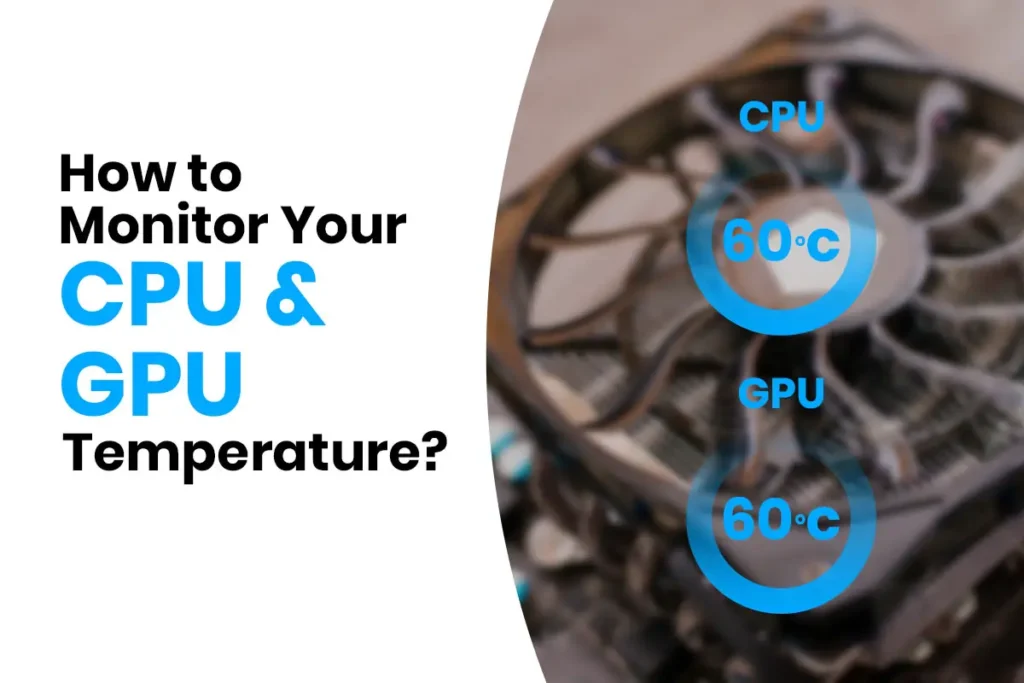CPU (Central Processing Unit) and GPU (Graphics Processing Unit), these two components are the heart of your computer. When it comes to your CPU and GPU, heat is your enemy. After all, overheating of these components is the leading cause of hardware failure reducing your computer’s lifespan. Therefore, you need to monitor your CPU and GPU temperature.
Today’s CPU and GPU are designed to work smoothly at a higher temperature. But, how will you know what temperature your system is running? On an average, while gaming or performing a heavy task, your system’s CPU or the GPU temperature should not exceed 80 Degree Celsius. Prolonged use of your system above 85 Degree Celsius will not only decrease the lifespan of your computer, but it will also cause CPU failure. In the worst-case scenario, you might need to replace your motherboard.
Monitoring your CPU and GPU temperature is vital when you have your system overclocked, or while you are playing games or doing heavy tasks. However, windows do not provide you with temperature monitoring tools or applications. So in this article, I am going to cover some of the tools that you can use to monitor your CPU and GPU temperatures. And also some of the tips on how to keep the temperature within the acceptable range.
Overheating is a common problem for gamers and media editors as these people push their CPU and GPU to the limit. So, if you are one of them, you’ve got to make sure you keep your temperature in check.
There are many third programs that you can download and use to monitor your CPU and GPU temperature. I have listed a few of them in this article.
Monitor Your CPU and GPU temperature
Always monitor your CPU and GPU temperature using one of the following methods to make your system run smoothly.
BIOS
The simplest way to check your core temperature without installing any applications is through BIOS. Different motherboard will have different BIOS interface. But every BIOS will have an option called “Hardware Monitor” through which you can find the CPU temperature.
To access the BIOS:
- Turn on or restart your computer,
- During the boot-up sequence, press the key that opens your BISO setting. The different device will have a different key to open the BIOS setting. However, Delete key, Function (F2, F9, F10, F, and F12) are the keys to open BIOS setting.
After accessing the BIOS, glance over the different tabs and open the CPU settings through which you can find CPU temperature. It might be scary if it is your first time accessing the BIOS setting. And, even if you did something wrong, or changed some setting, you don’t need to worry. Whenever you exit the BIOS, it will ask to save any changes. So, it’s easy to rectify any mistake you have made.
One downfall of using BIOS for monitoring your CPU temperature is that you need to restart your computer each and every time you want to check the temperature. If you need real-time solutions, keep on reading this article where I am going to reveal applications you can use to monitor your CPU and GPU temperature in your windows (while playing games).
CoreTemp
CoreTemp is one of the easiest ways to monitor your CPU and GPU temperature. What makes CoreTemp unique is the way it works and is compatible with most of the PCs as well. All the processors have DTS, Digital Thermal Sensor, in their processor. The DTS provides more accurate temperature readings than conventional thermal sensors. CoreTemp works by reading the Digital Thermal Sensor in your system’s processors. It is capable of displaying the temperature of the individual core of every processor in your computer. As CoreTemp has an easy to use interface, you will not find any difficulty operating the software. All you need to do is Download CoreTemp, install it in your computer and run the installed program.
CoreTemp is a free and lightweight program. It won’t cost you a penny and huge disk space.
Open Hardware Monitor
Like CoreTemp, Open Hardware Monitor is also a free, open-source software which is used to monitor your CPU and GPU temperature. Open Hardware Monitor has a slightly different user interface as compared to CoreTemp, which is much more comfortable and efficient to use. You will also find lots of information in Open Hardware Monitor like temperature, fan speed, voltage, load, and the clock speed of a computer.
Being an open-source program, the creator of Open Hardware Monitor application is continuously pushing new updated to fix bugs and features. So, this might be more accurate to monitor your CPU and GPU temperature.
MSI Afterburner
MSI Afterburner is by far the most popular application among gamers. An easy to use interface, good graphics, detailed analysis features, and many more have made MSI Afterburner a popular program among PC game players.
MSI Afterburner is Specially designed for your GPU; however, the program also provides reports on the status of your CPU.
One of the features that differentiate MSI Afterburner from other hardware monitor is that MSI Afterburner provides the functionality to adjust and customize the fan speed of your computer. Therefore, users can respond to high temperature changing their fan speed to cool their processor down.
Furthermore, MSI Afterburner provides user to record their computer screen. One advantage of using a screen recorder of MSI Afterburner is that you don’t need another program installed on your computer to record screen. This screen recording feature does not make this application a better one to monitor your CPU and GPU temperature. However, having a piece of software that does both the task is nice to have.
MSI Afterburner is specially designed for gamers who might need to record video and watch it later to publish it on YouTube. Likewise, PC gamers also need to watch their temperature, FPS, RAM consumption while playing a game. So, with the help of another program RivaTuner Statistics Server, gamers can monitor their graphics, RAM, processors while playing a game.
Use Guru3D RTSS (RivaTuner Statistics Server)
Whenever you download MSI Afterburner mentioned right above this subtopic, the package comes with RivaTuner Statistics Server RTSS and Direct X. Both of these programs “MSI Afterburner and RivaTuner Statistics Server” work together on both MSI Afterburner and RTSS to provide you with an in-game display of your system’s performance. This will help you monitor your CPU and GPU temperature more accurately.
NZXT Cam
NZXT CAM is another application that not only monitors your CPU and CPU temperature but also notifies you when your CPU and GPU temperatures get too high. Likewise, NZXT Cam also sends an automated message to let you know when you need to turn them down.
Like on MSI Afterburner with RivaTuner, NZXT Cam offers you in-game monitoring, tracking your FPS, temperatures, bandwidth and any more. NZXT Cam also lets you control your RGB lighting if you have installed your system and GPU overclocking.
NZXT Cam is a free tool. However, you can expect to get a lot of email and pop-ups advertisement. One advantage of NZXT Cam over other monitor tool is that it also offers a mobile version to monitor your CPU and GPU temperature remotely. Likewise, the app will also let you control your computer remotely.
CUPID HWMonitor
When it comes to monitoring your CPU and GPU temperature, CUPID HWMonitor is considered to be the best application.
Like other hardware monitor program, HWMonitor also retrieves data from the motherboard displaying all the sensor readout including, temperatures, voltage, fan speed, power supply, hardware utilization, clock speed, and fan speed.
HWMonitor is a lightweight program which does not take much of your disk space and is simple and easy to use. In HWMonitor, sensors are divided into subcategories which comes in different values – maximum value, minimum value, and current value.
CUPID HWMonitor comes in handy when you want to perform a quick monitor of your hardware and while overclocking or undervolting the system.
CPU Utilities
Both the Intel and AMD processor have their own processor tuning utility. The Ryzen Master is the Tuning utility of AMD whereas Extreme Tuning Utility is the tuning utility of Intel.
Both the Ryzen Master and Extreme Tuning Utility are easy to use and allows you to monitor overclocking, underclocking, and temperatures of your CPU.
The advantage of Ryzen Master over Extreme Tuning Utility is that Ryzen Master allows the user to monitor hardware information both real-time and histogram. However, both of these applications are free to download and is easy to use.
GPU Utilities (AMD and NVIDIAControl Panels)
AMD and NVIDIA both have their control panels for monitoring the temperature of your GPU. AMD has AMD Control Center whereas NVIDIA has the NVIDIA Control Panel to continually monitoring the GPU temperature in-game without having to exit the game to check the temperature.
NVIDIA Control Panel and the AMD Control Center are much more complicated than you think. However, they are free to download. If you are a beginner, look for tutorials online to get used to these utilities so that you don’t mess up with your GPU. This is the best way to prevent making any changes with your GPU that may harm your device.
GPU-Z Utility
GPU-Z Utility is the application specially designed for your GPU by TechPowerUp. This is a very popular application for checking information about your graphics card. You don’t require to install the software to use it, you download the application and use it copying it to your USB flash drive.
After downloading the application, click the Sensors tab, this will provide you GPU temperature, Clock Speed, memory clock, fan speed, and many more.
Real Temp
Real Temp is another hardware monitoring tool that is designed especially for Intel’s processors namely Intel single Core, Dual Core, Quad-Core, and Core 17 Processors.
You don’t require to install the program as its plug and play software. You download the application and run it and won’t cost you a penny. Therefore you can copy Real Temp on your USB flash drive and run it on any other compatible computer. Real Temp is a freeware hardware monitoring program that provides quick information about your hardware.
As the name describes, Real Temp monitors the temperature of your CPU and GPU collecting data from Digital Thermal Sensor (DTS) on your system.
Speccy
Speccy is a product designed to optimize computers. It analyzes most of the aspect of the computer from monitoring CPU temperature, GPU health to the condition of your motherboard. Speccy also allows the user to save their hardware reading as snapshots, XML file formats or text file.
{Image}
Piriform, the manufacturer of Speccy, offers three different versions of the application. These are Free, Professional, and Professional Plus, costing 19.95 for the Professional version and 39.95 for the Professional Plus version.
Even though the manufacturer provides the professional product, both the free and professional provides the same capabilities of monitoring your computer hardware. The only difference is that the professional version comes with automatic updates and premium support. Whereas, professional plus comes with CCleaner Professional, Recuva Professional, Defraggler Professional, and Speccy Professional.
However, if you are here just from monitoring your CPU and GPU temperature, the free version will work just fine. Although these features in the professional plus version may sound like a good deal but these aren’t worth the 40 bucks.
The Optimal Temperature of Intel and AMD CPU
No matter what tool you use to monitor your CPU and GPU temperature; it’s of no use if you don’t know what temperature your system should run at. Hardware Monitoring tools are there to track your system so that you can take actions if the temperature is getting high.
Typically there is no exact temperature that your CPU should run at as different versions of CPU has a different tolerant level. The optimal temperature depends on what processor you have, the version of that processor and the environment you are working on.
Let’s take an example if you are working on an AC room with temperature 26 Degree Celsius, and your CPU is in a well-ventilated desk. You will notice your CPU running at temperature 20% higher than the surrounding temperature. So, while performing light tasks, your system should be running at 25-35 Degree Celsius. Likewise, if you are editing videos, or playing games or performing any other heavy task, your CPU will get hotter than that. But you don’t need to panic, most of today’s CPU is designed to tolerate high temperature. Some can even perform normally above 100 Degree Celsius. The problem arises when the system is used in high temperature for a more extended period. So, make sure your CPU doesn’t get past 80 Degree Celsius when performing heavy task.
The Optimal Temperature of NVidia and AMD GPU
Similar to CPU you never want your GPU temperature to rise up. Typically at rest, your GPU temperature should be around 40 Degree Celsius as GPU temperature is always a little higher than that of CPU. Likewise, when you are gaming, the GPU temperature can get as high as 85 Degree Celsius. But, if it gets any hotter than you should be worrying. Because, once the GPU temperature overheats just once, it will most likely degrade much faster than that of CPU. So, always monitor your GPU temperature while gaming.
What Causes High Temperature in CPU and GPU
Various factors cause your CPU and GPU to overheat. The first and foremost cause of your CPU and GPU to overheat is most likely the Dust build up in your system or the cooling fan. Let’s look at some of the leading causes of high temperature in your CPU and GPU.
- First and foremost reason for your CPU and GPU temperature to rise is due to dust build-up in your system. Too much dust can clog the fan, decreasing cooling performance. Likewise, dust buildup in the heatsink also minimizes the cooling performance, causing CPU and GPU temperature to rise.
- As time passes, thermal paste on your processor tends to degrade which fails to transfer heat from the processor to the heatsink. Dried thermal paste will cause overheating or your CPU and GPU.
- If you are overclocking your system, it will definitely increase your CPU and GPU temperature.
- Some Malware infections or virus tends to use your processor, which causes your CPU to work much harder, causing higher temperature.
- If you have just purchased your computer and its overheating, this might be due to incorrectly placed heatsink. There is very tiny or no gap between the processor and the heatsink. So, when the heatsink is incorrectly placed, it might not transfer heat from the processor causing the processor to overheat.
If your Laptop is Overheating do look our previous article on how to fix an overheating laptop, this might help you out.
How to Lower CPU and GPU Temperatures
There are different ways to reduce CPU and GPU temperature, and here are some tips for doing so.
- Always allow better airflow in your system. Whether it is your laptop or your desktop computer. Add cooling fans to your desktop computer to increase airflow inside your system
- In case of your laptop, use a cooling pad to provide extra cool air inside your system.
- Always clean your computer once in a while as dust build up inside your system causes cooling fans or vents to clog keeps your cooling fan from operating efficiently. A clogged fan cannot run appropriately while clogged laptop vents keep air from getting into your system.
- Most people ignore the importance of cable management. Cable management lets air to circulate inside your system more efficiently so tidy your internals with cable ties.
- Thermal paste tends to degrade as the system gets old. Dry thermal past doesn’t perform better while transferring head from your processor to the heat dispense source. So it’s essential to pull off heatsink clean old thermal paste and reapply new thermal paste to your system.
- Always use your system in a well-ventilated area, as the external temperature impacts your CPU and GPU temperature. If your temperature is getting too high, try changing your system location as well.
- Try speeding up your fan speed; this will increase airflow inside your computer system.
- There are two types of cooling fans in your computer; one that sucks in the air and the other two exhausts hot air out of your computer casing. These two fans help in circulating cool air inside your computer system. So if you add some more fans tuning their speed, this might provide some more cooling in your CPU and GPU.
- Try adjusting your processor’s maximum power load from your control panel.
- If your system is overclocked, stop overclocking your system and restore the previous BIOS settings.
- Try undervolting your system. Right opposite to overvolting, it does not have any severe effect on your processor. If your system’s GPU or CPU is overheating undervolting can decrease the voltage supply decreasing the heat produced.
- A good PC case also has some impact on overheating CPU or GPU. Upgrade your PC case that offers a better airflow.
- You can even try liquid metal thermal paste they are way better than regular thermal paste. And will decrease your CPU or GPU temperature by at least 10 degree Celsius. And one advantage is that you don’t need to re-paste the liquid metal thermal paste.
- If nothing is working for you, upgrade your cooling system to water cooling. A liquid cooling system will definitely decrease your CPU and GPU heat. Water cooling kit is the most efficient way to cool your system; they are better than the most expensive and efficient heatsink coolers.
Read the article on How to Lower CPU Temperature to learn more.
Conclusion
I recommend you to monitor your CPU and GPU temperature once in a while. CPU and GPU are the most crucial part of our computer. So, it is essential to work within a safe range of temperature. Prolonged use of computer higher than recommended temperature will crash your system and can even destroy your motherboard. Luckily there is plenty of monitoring option in Windows 10 which you can use to monitor your CPU and GPU temperature. By doing so, you will be able to keep your system running smoothly.
Constant temperature monitoring goes a long way in maintaining the health of your system, ensuring that it works efficiently.
If your system is producing excess fan noise or heat, then there is probably an underlying issue which you need to fix. To lower CPU temperature, do read my previous article, where I have discussed the process and techniques in more detail.
Hopefully, this article might have given you a little information about how to monitor your CPU and GPU temperature and how you can minimize them.
If you have any queries, post them in the comment section below, I will definitely reply to your queries.





